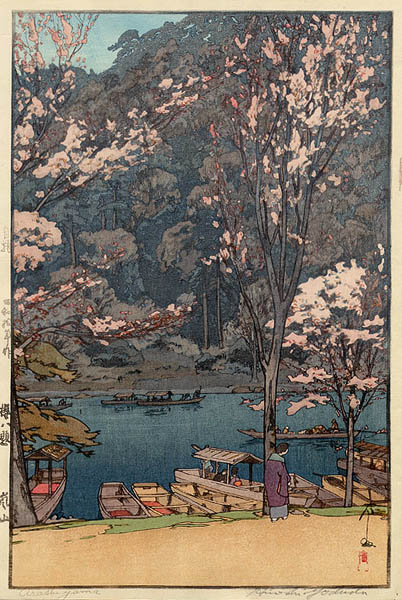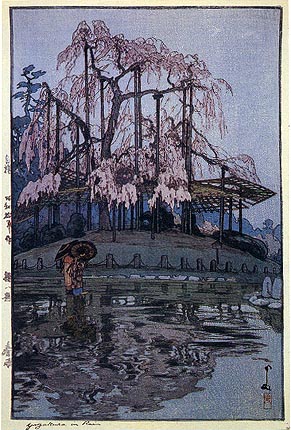Cherry Blossoms in Japanese Art and Culture
The flowering cherry tree is one of the cliché Western images of Japan, conjured up along with geisha, sushi, and samurai. However, within the country itself, the cherry blossoms have been a cultural event for over a thousand years. The annual hanami, cherry blossom viewing parties, the many cultural symbolic interpretations of the cherry blossoms, and the extensive use of the blossoms in art, for both their innate beauty and the symbolism they carry, have ensured the blossoming trees’ position in the cultural identity of Japan.
The cherry blossom holds much symbolism within Japan. According to the Buddhist tradition, the breathtaking but brief beauty of the blossoms symbolizes the transient nature of life. The flowers last for at most a few weeks, but during that time, both the mountains and the cities are full of the delicate pink flowers, be the trees wild or cultivated. “The traditional Japanese values of purity and simplicity are thought to be reflected in the form and color of the blossoms.” (Osamu, 1983) The cherry blossom is also tied with the samurai culture, representing the fleeting nature of the samurai’s life and symbolic of drops of blood. (Frederic, 2002)
The Yoshida Hiroshi print “Cherry Tree at Kawagoe” is part of the series “Eight Scenes of Cherry Blossoms”, which depicts a variety of views during the cherry blossom season. In each picture the blossoms are in a different state of development, rather than each depicting the blossoms at the height of their season and beauty. This highlights the transient nature of the blossoms which makes them all the more beautiful. One of the prints, “Yozakura in the Rain” depicts two brightly clad women under umbrellas in the middle distance gazing at slightly bedraggled trees in the background. The distance by which the viewer is removed from the events of the print contributes to the sense of melancholy and transitivity depicted in the print. This contrasts with another from the series, “Arashiyama” which depicts a boating scene on a river. The cherries blossoms are just beginning to emerge from their buds and the crew team passing the pleasure boats on the river adds a level of energy and joie de vivre to the print. The other prints in this series depict scenes that are as dissimilar as these two, but all of which are tied to the variety of meanings associated with cherry blossoms.
As cherry blossoms are symbolically tied with the samurai, they are depicted in several different forms of art tied with samurai culture. The symbol was used during the samurai period, so it is little wonder that the flowers appear in many objects of the day, such as folding screens, sliding doors, kimono and lacquer ware, as well as depictions of Samurai. “Pheasants Under Cherry and Willow Trees and Irises and Mist” is a pair of six panel folding screens attributed to Kano Ryokei, which as the piece’s title suggests, depicts a nature scene, including a blossoming cherry tree. The background of images is gold foil, a characteristic that states that the screens were probably intended for the use of a wealthy daimyo, or samurai baron. The 1884 woodblock print, “Warrior Taira-no-Tadanori about to sleep under a Cherry Tree”, centers on a gnarled cherry tree whose blooms are slowly drifting to the dark blue grey ground, with a poem to the left and the warrior dominating the right half of the print, removing his armor and preparing to rest. This print was done during the early Meiji period while the samurai were quickly losing their power, and the imagery of fading beauty and time passing would be quite prominent.
The cherry blossom festival of Japan is a time of parties so it is little wonder than many of the images of the cherry blossoms depict such scenes. Produced during the Kan’ei era of 1624-1644, “Partying Beneath Blossoming Cherry Trees” by Iwasa Matabei depicts two well-dressed gentlemen picnicking beneath cherry trees in the company of a young woman. The 3 panel “Cherry Blossom viewing at Asukayama” by Torii Kiyonaga was produced during the Edo period and shows men and women having a lively time while surrounded by the flowering trees. “Enjoying Cherry Blossoms by the Sumida River”, an 1887 woodblock print by Toyohara Chikanobu shows Japanese women in Western dress about to go boating on the river during the cherry blossom season. These three pieces span three eras of Japanese history, but depict similar scenes of merriment. In all three the blossoms are at their fullest, but not yet falling, state.
In modern Japan, the blossoms continue to be celebrated by hanami, cherry blossom viewing excursions. While the original intent of these parties was to view the blossoms and focus on the transient nature of life, the picnics now present a more “Eat, drink, and be merry” element. Lavish picnics with plentiful sake and karaoke for entertainment are now the norm, but the tradition continues beneath the beautiful blossoms. The image of the cherry blossom, with its close connections with spring, is widely used in Japanese advertising, from candy to a type of film to express trains. This connection to spring, as well as innocence, delicacy and simplicity have made the blossoms popular with events and products tied to weddings and school openings. ( Kobayashi, 2002) The Japanese school term begins in April, making the cherry blossom much like the American symbol of the apple in relation to the first day of school.
Cherry blossoms have been prominent in Japanese art and culture since time unrecorded. The first mention of the blossoms appears in the first history of Japan, written in 712. (Osamu, 1983) Because the blossoms are so interwoven throughout symbolism, art and society of Japan, it is likely that these blossoms will be important to the culture as long as the trees continue to bloom each spring.
Bibliography
Frederic, Louis. (2002). Japan Encyclopedia. Cambridge, Mass: Belknap Press of Harvard University Press.
Kano Ryokei. Pheasants Under Cherry and Willow Trees and Irises and Mist. Nishihongaji, Kyoto Prefecture, Japan. http://www.artstore.org
Kobayoshi, Audrey. (2002). Cherry Blossom. In Encyclopedia of contemporary Japanese culture. (p. 63). Lodon; New York: Routledge.
Kyobayashi Kiyochika. Warrior Taira-no-Tadanori about to Sleep under a Cherry Tree. 1884. Los Angeles County Museum of Art, Los Angeles, CA. http://www.artstore.org
Iwasa Matabei. Partying Beneath Blossoming Cherry Trees. Museum of Fine Arts, Boston Mass. http://www.artstore.org
Matsuda, Osamu. (1985) Cherry Blossom. In Kodansha Encyclopedia of Japan. (Vol. 1, pp. 269-270). Tokyo; New York: Kodansha.
Torii Kiyanaga. Cherry Blossom Viewing at Asuka-yama. Private Collection, Japan. http://www.artstore.org
Toyohara Chikanobu. Enjoying Cherry Blossoms by the Sumida River. 1887. Museum of Fine Arts, Boston Mass. http://www.artstore.org
Yoshida Hiroshi. Arashiyama. 1935. http://www.hanga.com/viewimage.cfm?ID=196
Yoshida Hiroshi. Yozakura in the Rain. 1935. http://www.hanga.com/viewimage.cfm?ID=194

